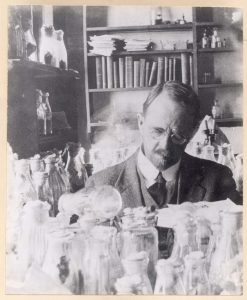As billions of Brood X cicadas get ready to emerge from the ground, we look back to the billions of fruit flies (Drosophila melanogaster) that helped a former Columbia faculty member claim the 1933 Nobel Prize for Medicine or Physiology. Thomas Hunt Morgan (faculty 1904-1928) and his team of researchers laid the foundations to modern genetics by studying the inherited characteristics of the fruit fly.

Every month, the National Archives hosts an archives hashtag party: a theme (and a hashtag) is chosen to highlight some of NARA’s holdings on their various social media channels. Archives, museums, and historical societies are all invited to join the party and share their own related records and documents. The Columbia University Archives first joined the party in February 2021, #ArchivesBlackEducation, and shared photos of former faculty member Manning Marable and alumnus and Trustee Dr. Rev. M. Moran Weston. For the month of May and in anticipation of Brood X, this #ArchivesHashtagParty is all about bugs: #ArchivesBugs. And when thinking about bugs, our thoughts turned to the “Fly Room,” as Schermerhorn 613 was once known.
In 1904 Thomas Hunt Morgan joined Columbia as the first chair of experimental zoology. A few years later, around 1907, Morgan began to focus his work on genes and inherited traits in fruit flies. Drosophila are easy to raise in a lab, are small (a thousand can be collected in a one-quart glass milk bottle) and, well, fruitful (they can produce a new generation every 12 days). More importantly for geneticists, fruit flies only have 4 pairs of chromosomes. Over the next 10 years, billions of fruit flies and the chromosomal theory of heredity were born in Morningside.
Beyond the development of theory, according to Eric R. Kandel, there is another aspect of Morgan’s lasting legacy. The “Fly Room” in Schermerhorm Hall was a small room (16 x 23 feet) with eight desks where students and researchers could share their ideas and methods. Kandel argues that the “open, critical, yet fully democratic and egalitarian atmosphere that was evident in the Fly Room” became the prototype for a “distinctively American atmosphere of university research.” In fact, when Morgan was awarded the Nobel Prize in 1933, he shared his prize money with his former students, Alfred Henry Sturtevant, CC 1912 PhD 1914, and Calvin Bridge, CC 1912 PhD 1916.

At the University Archives, we are fortunate to have the notebooks of James Paul “Jimmie” Chapin (CC 1916, MA 1919, PhD 1932), including those from his time as a student in Prof. Morgan’s Zoology 215-216: Genetics taken in 1919-1920. With his notes from the lecture on October 15, 1919, Chapin includes this illustration of the male and female fruit flies with their parts identified. The notebook also includes Chapin’s lab observations: for each numbered bottle (1-10), he records the number of male and female fruit flies and their salient features. Chapin’s notebooks from 1915-1921 are part of the Columbiana Manuscripts.
You can find our #ArchivesHashtagParty contributions posted on the RBML’s Instagram account, @columbia_rbml, and on the Columbia Libraries Twitter account, @columbialib. The parties are normally held on the first Friday of the month so look for the #ArchivesBugs party on Friday, May 7.